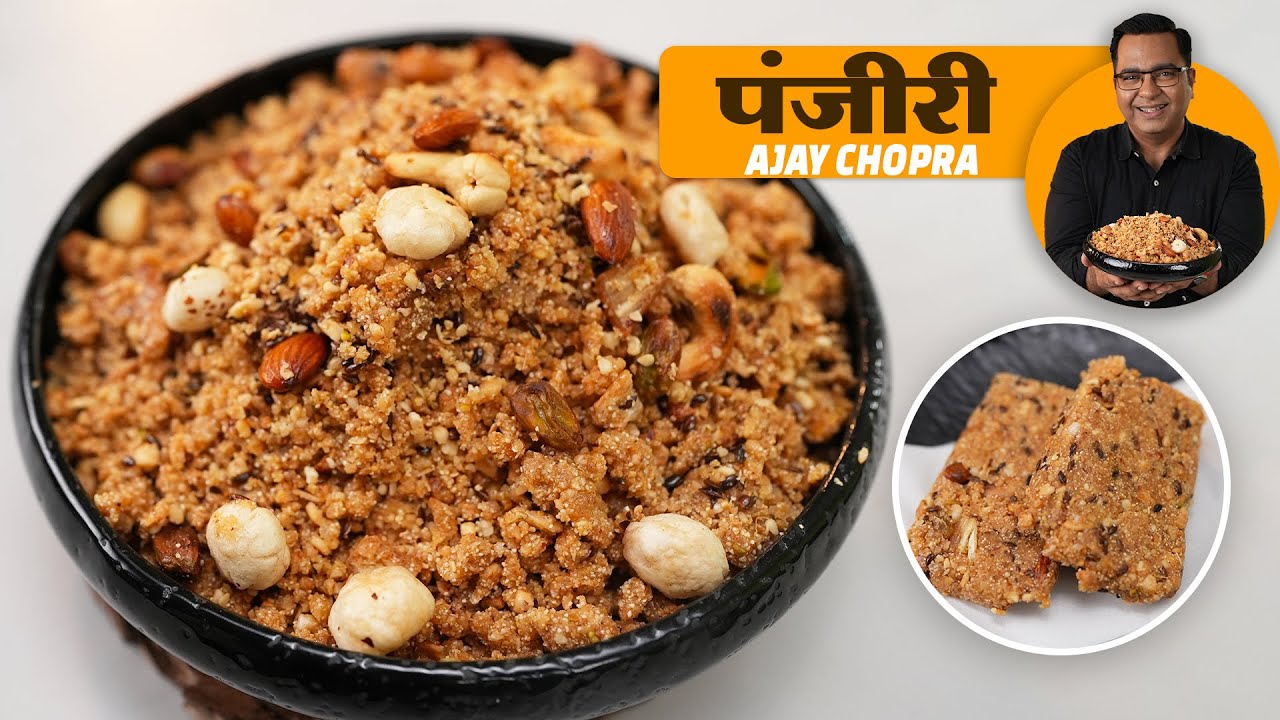
Panjiri Recipe

40 Mins

9-10 People

10 Mins
Introduction
Panjiri holds a special place in my heart as it reminds me of my grandmother's warm kitchen filled with the aroma of traditional Indian sweets. I vividly recall sitting by her side, watching her meticulously prepare this nutritious delicacy during festive occasions. The process was not just about cooking; it was a ritual, a way to connect with our cultural roots and bond with loved ones. As she shared stories of her own childhood adventures, I learned that Panjiri has been a beloved treat in Indian households for generations. Its rich blend of ingredients, including whole wheat flour, ghee, nuts, and spices, not only tantalizes the taste buds but also nourishes the body and soul. Today, whenever I prepare Panjiri, I am transported back to those cherished moments, honoring the legacy of love and tradition that my grandmother bestowed upon me.
Recipe of Panjiri
Servings: 9-10
Preparation Time: 10 minutes
Cooking Time: 40 minutes
Calories: Approximately 560 calories per portion
Ingredients:
For Panjiri:
- ⅔ cup Ghee
- ½ cup Walnuts
- ½ cup Almonds
- ½ cup Cashew nuts
- ¼ cup Pista
- 2 tbsp Alsi / Flax seeds
- ¼ cup Melon seeds
- 2 cups Makhana
- ¼ cup Kharik (Dried dates)
- ¼ cup Raisins
- ½ cup Desiccated coconut
- 1 cup Suji (Semolina)
- 1 tsp Green cardamom powder
- 1 tbsp Dry ginger powder
- 1 cup Jaggery
- Water as required
- Parchment paper
Instructions:
1. Preparation:
- Heat a pan and add a generous amount of ghee. Add kharik (dried dates) and raisins, cooking until they become tender. Transfer this mixture to a bowl and set aside.
- In the same pan, add more ghee and toast walnuts, almonds, cashew nuts, pista, alsi (flaxseeds), and melon seeds. Add makhana (fox nuts) and toast them with the nuts. Once toasted, set the mixture aside.
- Roast desiccated coconut in ghee until it turns light golden brown. Transfer it to a plate to cool.
- In the same pan, add more ghee and roast suji (semolina) until it achieves a light golden brown color. Transfer it to a plate and let it cool.
- Crush gondh (edible gum) into a coarse texture using a mixer jar and set it aside.
2. Making Panjiri:
- Grind the toasted nuts mixture and the reserved crushed gondh in a mixer jar into a coarse powder, ensuring a balanced blend of flavors and textures.
- Combine all the prepared ingredients in a bowl, including the roasted coconut, suji, green cardamom powder, and dry ginger powder.
- For the jaggery syrup, heat ghee in a pan, add jaggery, and a bit of water to make a rich, sweet syrup.
- Add the toasted nuts and kharik-raisin mixture to the Panjiri mixture, incorporating the jaggery syrup to bind the ingredients together. Mix thoroughly for an even distribution of flavors.
3. Storage and Serving:
- Panjiri is now ready to be served, offering a wholesome and flavorful treat. Store it in an airtight glass jar to maintain its freshness.
- For Panjiri Bars: Take a portion of the Panjiri mixture in a bowl, add the toasted dry fruit mixture (excluding makhana), and blend them together. Introduce jaggery syrup to bind the mixture, creating a cohesive texture. Shape the mixture into bars, wrap them with parchment paper, and refrigerate until solidified.
About the Recipe
Panjiri is a traditional Indian sweet made from whole wheat flour, ghee (clarified butter), sugar, nuts, and aromatic spices. It is often prepared during special occasions and festivals, such as weddings, childbirth ceremonies, and religious festivities. This wholesome treat is believed to have originated in the Indian subcontinent and holds cultural significance across various regions. Panjiri is cherished not only for its delicious taste but also for its numerous health benefits. It is considered a nutritious winter food that provides warmth and energy to the body, making it especially popular during the colder months. Additionally, Panjiri is believed to aid digestion, boost immunity, and provide nourishment to new mothers during the postpartum period.
Cooking Tips
- Slow Roasting: Take your time to slow roast the whole wheat flour in ghee until it turns golden brown, as this process enhances the flavor and aroma of the Panjiri.
- Even Mixing: Ensure that all the ingredients are evenly mixed to achieve a uniform texture and taste.
- Adjust Sweetness: Adjust the amount of sugar according to your preference, keeping in mind that Panjiri is traditionally mildly sweet.
- Variations: Feel free to customize your Panjiri by adding or omitting nuts and spices based on personal taste and dietary preferences.
- Storage: Store Panjiri in an airtight container to maintain its freshness and flavor for an extended period.
Pairing Guide
- Tea or Milk: Enjoy Panjiri with a cup of hot tea or milk for a comforting and satisfying snack.
- Fresh Fruits: Pair Panjiri with fresh fruits such as bananas, apples, or oranges for a refreshing contrast of flavors.
Frequently Asked Questions about Panjiri
- What does Panjiri taste like?
- Panjiri has a rich, nutty flavor with a hint of sweetness and aromatic spices.
- Is Panjiri suitable for vegetarians?
- Yes, Panjiri is vegetarian-friendly as it contains no animal products other than ghee, which can be substituted with clarified butter made from plant-based sources.
- Can Panjiri be made gluten-free?
- Yes, you can make gluten-free Panjiri by using gluten-free flour alternatives such as rice flour or almond flour.
- Is Panjiri suitable for diabetics?
- Panjiri contains sugar, so it should be consumed in moderation by individuals with diabetes, keeping in mind their dietary restrictions and monitoring blood sugar levels.
- How long does Panjiri stay fresh?
- When stored in an airtight container in a cool, dry place, Panjiri can stay fresh for up to several weeks.
- Can Panjiri be frozen?
- Yes, you can freeze Panjiri in an airtight container for longer storage. Thaw it at room temperature before consuming.
- What are the health benefits of Panjiri?
- Panjiri is believed to aid digestion, provide warmth and energy during the winter months, boost immunity, and offer nourishment to new mothers during the postpartum period.
- Can Panjiri be served to children?
- Yes, Panjiri can be served to children in moderation as a nutritious snack, but it is advisable to avoid giving it to very young children due to its firm texture.
- Is Panjiri a traditional Indian sweet?
- Yes, Panjiri is a traditional Indian sweet that has been enjoyed for centuries, particularly during special occasions and festivals.
- What is the significance of Panjiri in Indian culture?
- Panjiri holds cultural significance in Indian households as a symbol of celebration, tradition, and nourishment, often prepared during auspicious occasions and shared with family and friends.
